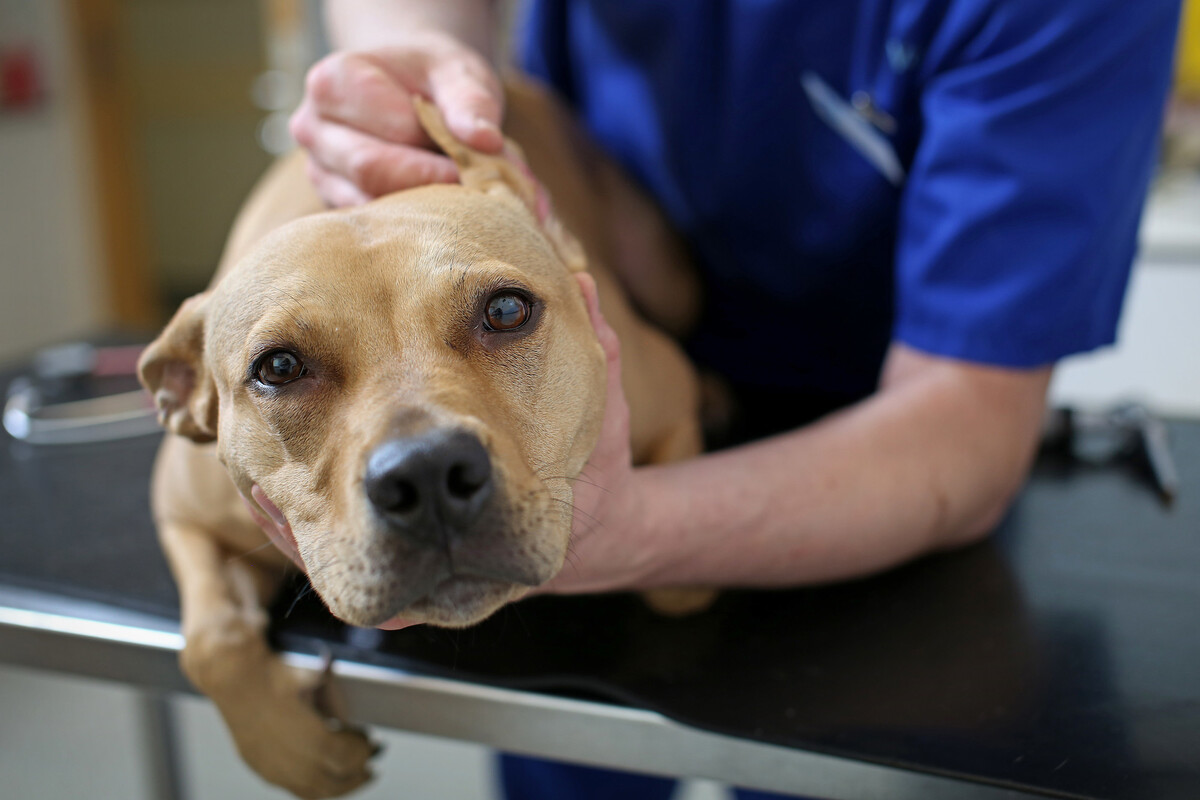Home>Health & Wellness>Common Health Issues>Heart Health>What Does A Heartworm Cough Sound Like In A Dog?


Heart Health
What Does A Heartworm Cough Sound Like In A Dog?
Published: February 7, 2024
Learn about heart health in dogs and what a heartworm cough sounds like. Understand the signs and symptoms to keep your pet healthy.
(Many of the links in this article redirect to a specific reviewed product. Your purchase of these products through affiliate links helps to generate commission for Pawsomeoldies.com, at no extra cost. Learn more)
Table of Contents
Introduction
Heartworm disease is a serious and potentially fatal condition that can affect our beloved canine companions. As responsible pet owners, it's crucial to understand the implications of this disease and how it can impact the health and well-being of our furry friends. By gaining insight into the nature of heartworm disease, its symptoms, and the importance of prevention, we can take proactive measures to safeguard our dogs from this debilitating illness.
Heartworm disease is caused by a parasitic worm known as Dirofilaria immitis, which is transmitted through the bite of an infected mosquito. Once inside a dog's body, these worms can grow and multiply, eventually leading to severe damage to the heart, lungs, and blood vessels. The presence of heartworms can compromise the overall cardiovascular function of the affected dog, potentially resulting in life-threatening consequences if left untreated.
Understanding the transmission and progression of heartworm disease is essential for pet owners, as it enables us to recognize the signs and symptoms that may indicate our dog has been infected. By being vigilant and proactive, we can seek timely veterinary care and intervention, thereby improving the chances of successful treatment and recovery for our furry companions.
In this comprehensive guide, we will delve into the various aspects of heartworm disease in dogs, including its symptoms, diagnostic methods, treatment options, and preventive measures. By equipping ourselves with this knowledge, we can become proactive advocates for our dogs' health and well-being, ensuring that they are protected from the potentially devastating effects of heartworm disease. Let's embark on this enlightening journey to gain a deeper understanding of heartworm disease and empower ourselves to make informed decisions for the welfare of our canine companions.
Read more: What Does A Tick Scab Look Like On A Dog?
Understanding Heartworm Disease
Heartworm disease is a potentially life-threatening condition that primarily affects dogs, although it can also occur in other mammal species, including cats and ferrets. The disease is caused by the parasitic worm Dirofilaria immitis, which is transmitted through the bite of infected mosquitoes. When an infected mosquito bites a dog, it deposits microscopic heartworm larvae onto the skin, which then enter the dog's bloodstream through the mosquito's bite wound.
Once inside the dog's body, the heartworm larvae undergo several developmental stages before reaching the heart and pulmonary arteries. Over time, these larvae mature into adult worms, with females reaching lengths of up to 12 inches. The presence of these worms in the heart and pulmonary arteries can lead to severe cardiovascular complications, including damage to the heart muscle, blood vessels, and lungs.
The life cycle of the heartworm involves several stages, beginning with the transmission of microfilariae (immature heartworms) from an infected animal to a mosquito during a blood meal. Once inside the mosquito, the microfilariae develop into infective larvae, which can then be transmitted to another animal through a mosquito bite. When a susceptible animal is bitten by an infected mosquito, the larvae enter the new host's bloodstream, initiating the cycle once again.
The severity of heartworm disease can vary depending on factors such as the number of worms present, the duration of the infection, and the dog's immune response. In some cases, dogs may show minimal or no symptoms during the early stages of infection, making it challenging to detect the presence of heartworms without specific diagnostic tests.
Understanding the life cycle and transmission of heartworm disease is crucial for pet owners, as it highlights the importance of preventive measures, such as regular administration of heartworm preventatives and mosquito control. By disrupting the transmission cycle and protecting our dogs from mosquito bites, we can significantly reduce their risk of contracting this debilitating disease.
As responsible pet owners, it is essential to stay informed about the prevalence of heartworm disease in our geographical area and work closely with veterinarians to implement effective prevention strategies. By taking proactive measures to safeguard our dogs from heartworm infection, we can help ensure their long-term health and well-being.
Symptoms of Heartworm Disease in Dogs
Recognizing the symptoms of heartworm disease in dogs is crucial for early detection and intervention. While the severity of symptoms can vary depending on factors such as the number of worms present and the dog's immune response, it's essential to be vigilant and observant of any potential signs of illness.
-
Mild Symptoms: In the early stages of heartworm disease, dogs may exhibit subtle signs such as occasional coughing, decreased exercise tolerance, and mild lethargy. These symptoms can often be overlooked or attributed to other causes, making it challenging to identify the underlying presence of heartworms.
-
Persistent Cough: As the disease progresses, dogs may develop a persistent cough, which is often described as a soft, dry cough. This cough may worsen after physical activity or when the dog is lying down, as the presence of heartworms in the pulmonary arteries can lead to irritation and inflammation, triggering the coughing reflex.
-
Exercise Intolerance: Dogs with heartworm disease may display reluctance to engage in physical activities that they previously enjoyed. This reduced exercise tolerance can be attributed to the compromised cardiovascular function caused by the presence of heartworms, leading to fatigue and shortness of breath during exertion.
-
Lethargy and Weakness: As the disease advances, affected dogs may exhibit increased lethargy and weakness, often manifesting as a lack of energy, reluctance to move, and overall decreased activity levels. These symptoms can be indicative of the systemic impact of heartworm infection on the dog's overall health and well-being.
-
Respiratory Distress: In severe cases of heartworm disease, dogs may experience respiratory distress, characterized by rapid or labored breathing, wheezing, and cyanotic (bluish) mucous membranes. This is a critical indication of advanced cardiovascular compromise and warrants immediate veterinary attention.
-
Weight Loss and Poor Condition: Dogs suffering from heartworm disease may experience unexplained weight loss and a decline in body condition, despite maintaining a regular appetite. The metabolic demands imposed by the presence of heartworms can lead to a loss of muscle mass and overall deterioration in the dog's physical condition.
-
Cardiovascular Complications: In advanced stages of heartworm disease, dogs may develop cardiovascular complications such as heart murmurs, arrhythmias, and fluid accumulation in the abdomen (ascites) or chest cavity (pleural effusion). These complications reflect the profound impact of heartworm infection on the dog's cardiovascular system.
By being attentive to these potential symptoms of heartworm disease, pet owners can promptly seek veterinary evaluation and diagnostic testing to confirm the presence of heartworms and initiate appropriate treatment. Early detection and intervention are paramount in improving the prognosis for dogs affected by heartworm disease, underscoring the significance of proactive monitoring and preventive measures.
What Does a Heartworm Cough Sound Like?
A heartworm cough in dogs is often described as a soft, dry cough that can become more pronounced as the disease progresses. This distinctive cough is a result of the presence of heartworms in the pulmonary arteries, which can lead to irritation and inflammation, triggering the coughing reflex. Unlike a typical cough associated with respiratory infections or minor irritants, a heartworm cough tends to persist and may worsen after physical activity or when the dog is lying down.
The sound of a heartworm cough is often characterized by its dry and persistent nature, resembling a hacking or honking noise that emanates from the dog's respiratory system. Pet owners may notice that the cough becomes more frequent or pronounced over time, especially during moments of exertion or excitement. In some cases, the cough may be accompanied by a gagging reflex, reflecting the underlying respiratory discomfort caused by the presence of heartworms.
It's important to note that the sound of a heartworm cough can vary among individual dogs, and the intensity of the cough may depend on factors such as the number of worms present, the dog's overall health, and the stage of the disease. While some dogs may exhibit a mild and occasional cough, others may experience more frequent and persistent episodes of coughing, signaling a more advanced stage of heartworm disease.
As the disease progresses, the cough may become increasingly noticeable, serving as a crucial indicator of potential heartworm infection in dogs. Pet owners should pay close attention to the characteristics of their dog's cough, particularly its duration, frequency, and any associated respiratory distress. Any changes in the sound or pattern of the cough should prompt immediate veterinary evaluation to assess the possibility of heartworm disease and initiate appropriate diagnostic testing.
By familiarizing themselves with the distinct sound of a heartworm cough, pet owners can play a proactive role in identifying potential signs of heartworm disease in their dogs. Early recognition of the cough's unique characteristics can facilitate timely veterinary intervention, leading to prompt diagnosis and treatment, thereby improving the prognosis for dogs affected by this debilitating condition.
Diagnosing Heartworm Disease
Diagnosing heartworm disease in dogs involves a comprehensive approach that encompasses clinical evaluation, diagnostic testing, and the interpretation of results by veterinary professionals. Given the potential severity of heartworm infection, timely and accurate diagnosis is essential for initiating appropriate treatment and mitigating the impact of the disease on the affected dog's health.
Read more: What Does Cancer On A Dog’s Toe Look Like
Clinical Assessment
Veterinarians begin the diagnostic process by conducting a thorough clinical assessment of the dog, which may include a detailed medical history, physical examination, and evaluation of presenting symptoms. During the physical examination, particular attention is paid to assessing the dog's cardiovascular and respiratory status, as well as identifying any potential signs of heartworm disease, such as coughing, exercise intolerance, and abnormal lung or heart sounds.
Heartworm Antigen Test
One of the primary diagnostic tests for heartworm disease in dogs is the antigen test, which detects the presence of specific proteins (antigens) produced by adult female heartworms. This test typically involves obtaining a small blood sample from the dog and using a specialized assay to detect the presence of heartworm antigens. A positive antigen test result indicates the presence of adult heartworms in the dog's body, prompting further evaluation and confirmation.
Microfilariae Test
In cases where heartworm infection is suspected, veterinarians may also perform a microfilariae test to detect the presence of immature heartworms in the dog's bloodstream. This test involves examining a blood sample under a microscope to identify and characterize microfilariae, providing additional evidence of heartworm infection. While the presence of microfilariae does not confirm the presence of adult heartworms, it can support the overall diagnosis and treatment plan.
Radiographic Imaging
Radiographic imaging, such as chest X-rays (radiographs), may be utilized to assess the extent of cardiovascular and pulmonary changes associated with heartworm disease. These imaging studies can reveal abnormalities in the size and shape of the heart, as well as the presence of pulmonary infiltrates or vascular changes indicative of heartworm-related pathology. Radiographic findings can aid in staging the severity of the disease and guiding treatment decisions.
Read more: What Does A Tick Look Like In Dog Skin
Echocardiography
Echocardiography, or cardiac ultrasound, is a valuable diagnostic tool for evaluating the structural and functional aspects of the heart, including the presence of heartworms within the cardiac chambers and pulmonary arteries. This non-invasive imaging modality provides detailed insights into the cardiovascular system, allowing veterinarians to visualize the anatomical changes associated with heartworm disease and assess the impact on cardiac function.
Additional Diagnostic Considerations
In some cases, additional laboratory tests, such as complete blood counts (CBC), serum biochemistry panels, and coagulation profiles, may be performed to evaluate the overall health status of the dog and assess potential complications associated with heartworm disease. These tests can provide valuable information about the dog's systemic condition and help guide the management of concurrent health issues.
By integrating these diagnostic approaches and interpreting the results in conjunction with the dog's clinical presentation, veterinarians can establish a definitive diagnosis of heartworm disease and develop a tailored treatment plan to address the specific needs of the affected dog. The comprehensive nature of the diagnostic process underscores the importance of seeking professional veterinary care and expertise in managing heartworm disease, ultimately contributing to improved outcomes for dogs facing this challenging condition.
Treatment Options for Heartworm Disease
The treatment of heartworm disease in dogs requires a multifaceted approach aimed at eliminating the adult worms, managing associated complications, and supporting the dog's overall health during the recovery process. It is essential to emphasize that the treatment of heartworm disease should be overseen by a qualified veterinarian, as it involves specific protocols and considerations to ensure the safety and well-being of the affected dog.
Stabilization and Pre-Treatment Evaluation
Before initiating treatment for heartworm disease, veterinarians may focus on stabilizing the dog's condition and conducting pre-treatment evaluations to assess the extent of cardiovascular and pulmonary involvement. This may involve addressing concurrent health issues, optimizing the dog's cardiovascular function, and conducting additional diagnostic tests to guide the treatment plan.
Read more: What Does Arthritis Look Like In A Dog?
Adulticide Therapy
The primary goal of heartworm treatment is to eliminate the adult worms residing in the dog's heart and pulmonary arteries. This is typically achieved through the administration of adulticide medications, which are designed to kill the adult heartworms over a specified treatment period. These medications work by targeting the heartworms and facilitating their gradual breakdown and elimination from the dog's body.
Exercise Restriction
During the treatment period, dogs undergoing heartworm adulticide therapy are typically required to adhere to strict exercise restriction protocols. This is essential to minimize the risk of complications associated with the sudden death of heartworms and to reduce the strain on the dog's cardiovascular system. Pet owners are advised to closely follow the prescribed activity limitations to ensure the safety and effectiveness of the treatment process.
Management of Complications
In cases where heartworm disease has led to cardiovascular or respiratory complications, supportive care and management of associated symptoms may be necessary. This can involve the use of medications to address pulmonary inflammation, heart failure, or other systemic effects of heartworm infection. Veterinarians may tailor the treatment approach to address the specific needs and challenges presented by individual cases.
Post-Treatment Monitoring
Following the completion of adulticide therapy, dogs are typically subjected to post-treatment monitoring to assess their response to treatment and evaluate the resolution of heartworm infection. This may involve follow-up diagnostic tests, such as antigen testing and imaging studies, to confirm the successful elimination of heartworms and monitor the dog's cardiovascular recovery.
Read more: How Does A Heartworm Affect Dogs
Preventive Measures
After completing treatment for heartworm disease, pet owners are strongly encouraged to implement rigorous preventive measures to protect their dogs from future heartworm infection. This includes the regular administration of heartworm preventatives, mosquito control strategies, and ongoing veterinary care to maintain the dog's cardiovascular health.
By addressing the complexities of heartworm disease treatment and embracing a comprehensive approach that encompasses adulticide therapy, supportive care, and preventive strategies, veterinarians can optimize the chances of successful outcomes for dogs affected by this challenging condition. The collaborative efforts of pet owners and veterinary professionals are instrumental in navigating the treatment journey and promoting the long-term well-being of dogs recovering from heartworm disease.
Preventing Heartworm Disease in Dogs
Preventing heartworm disease in dogs is a fundamental aspect of responsible pet ownership, aimed at safeguarding canine companions from the potentially devastating effects of this parasitic infection. By implementing proactive measures and adhering to preventive protocols, pet owners can significantly reduce the risk of heartworm transmission and ensure the long-term health and well-being of their beloved dogs.
Regular Administration of Preventatives
Central to heartworm disease prevention is the regular administration of heartworm preventatives, which are available in various formulations, including oral medications, topical solutions, and injectable products. These preventatives work by disrupting the development of heartworm larvae transmitted by mosquitoes, thereby preventing the establishment of adult heartworms in the dog's body. Pet owners should consult with their veterinarians to select the most suitable preventative product based on their dog's health status, lifestyle, and environmental factors.
Year-Round Compliance
Maintaining year-round compliance with heartworm preventatives is essential, as it ensures continuous protection against potential mosquito exposure, regardless of seasonal variations. Consistent administration of preventatives mitigates the risk of lapses in protection and minimizes the likelihood of heartworm transmission, especially in regions where mosquitoes are prevalent throughout the year. By adhering to a year-round preventive regimen, pet owners can uphold a proactive defense against heartworm disease for their dogs.
Regular Veterinary Check-ups
Routine veterinary check-ups play a pivotal role in heartworm prevention, as they enable veterinarians to assess the dog's health status, discuss preventive strategies, and provide guidance on effective parasite control. During these visits, veterinarians may conduct heartworm testing, recommend appropriate preventatives, and offer tailored advice on mosquito control measures. By engaging in regular communication with veterinarians, pet owners can stay informed about the latest preventive recommendations and optimize their dogs' protection against heartworm disease.
Mosquito Control Strategies
In addition to administering preventatives, implementing mosquito control strategies in the dog's environment can further reduce the risk of heartworm transmission. This may involve minimizing standing water sources, using mosquito repellents designed for pets, and employing environmental treatments to deter mosquito breeding and activity. By addressing potential mosquito habitats and reducing exposure to these vectors, pet owners can enhance the overall effectiveness of heartworm prevention efforts.
Geographic Considerations
Understanding the prevalence of heartworm disease in specific geographical areas is crucial for tailoring preventive measures to the local risk factors. Pet owners residing in regions with high mosquito activity and documented cases of heartworm infection should prioritize comprehensive preventive strategies and remain vigilant in protecting their dogs from potential exposure. By staying informed about regional disease patterns, pet owners can adapt their preventive approach to align with the specific challenges posed by their location.
Education and Awareness
Promoting education and awareness about heartworm disease within the pet owner community is essential for fostering a collective commitment to prevention. By sharing information about the transmission, symptoms, and preventive strategies related to heartworm disease, pet owners can empower each other to prioritize their dogs' health and take proactive measures to mitigate the risk of infection. Open dialogue and knowledge sharing contribute to a culture of vigilance and responsibility in preventing heartworm disease in dogs.
By embracing a comprehensive approach to heartworm prevention, pet owners can create a protective shield around their dogs, minimizing the threat of heartworm infection and preserving their overall well-being. Through a combination of preventive measures, regular veterinary oversight, and environmental management, pet owners can champion the health and vitality of their canine companions, ensuring a future free from the burdens of heartworm disease.
Read more: What Does A Dog’s Eye Look Like
Conclusion
In conclusion, the impact of heartworm disease on dogs is a significant concern for pet owners, necessitating a proactive and informed approach to safeguarding the health and well-being of canine companions. By gaining a comprehensive understanding of the disease, its symptoms, diagnostic methods, treatment options, and preventive measures, pet owners can empower themselves to make informed decisions and advocate for the long-term welfare of their dogs.
Recognizing the subtle signs and symptoms of heartworm disease, such as persistent coughing, exercise intolerance, and lethargy, serves as a crucial first step in identifying potential cases of infection. Understanding the distinct sound of a heartworm cough and being attentive to any respiratory distress can prompt timely veterinary evaluation and diagnostic testing, leading to early detection and intervention.
The diagnostic process for heartworm disease involves a multifaceted approach, encompassing clinical assessment, antigen testing, microfilariae testing, radiographic imaging, echocardiography, and additional laboratory evaluations. By collaborating with veterinary professionals and leveraging these diagnostic tools, pet owners can facilitate the accurate diagnosis of heartworm disease and initiate tailored treatment plans to address the specific needs of their dogs.
Treatment of heartworm disease requires a comprehensive strategy, including adulticide therapy, exercise restriction, management of complications, and post-treatment monitoring. By adhering to these protocols and engaging in collaborative care with veterinarians, pet owners can optimize the chances of successful outcomes for dogs undergoing treatment, ultimately promoting their recovery and long-term well-being.
Furthermore, the prevention of heartworm disease is paramount in mitigating the risk of infection and reducing the impact of this debilitating condition. Through the regular administration of preventatives, year-round compliance, veterinary oversight, mosquito control strategies, and geographic considerations, pet owners can establish a robust defense against heartworm transmission, safeguarding their dogs from potential exposure.
By embracing a culture of education, awareness, and proactive prevention, pet owners can champion the health and vitality of their dogs, ensuring a future free from the burdens of heartworm disease. Through ongoing vigilance, responsible pet ownership, and collaboration with veterinary professionals, we can create a supportive environment where dogs can thrive, protected from the challenges posed by heartworm infection.
In essence, the journey to combat heartworm disease in dogs is a collective effort, driven by knowledge, compassion, and a steadfast commitment to the well-being of our beloved canine companions. By uniting in our dedication to prevention, early detection, and comprehensive care, we can navigate the complexities of heartworm disease and pave the way for a future where dogs can lead healthy, vibrant lives, free from the threat of this insidious parasitic infection.









